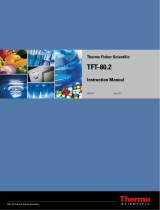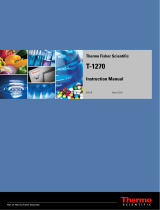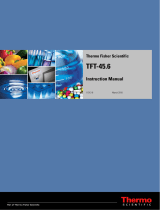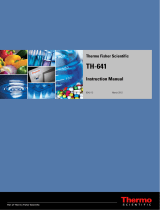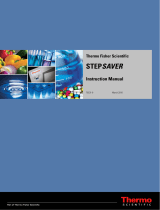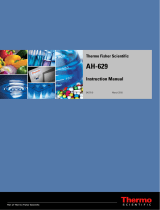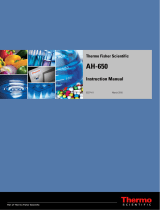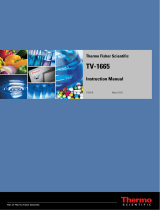Page is loading ...

54355-6 March 2010
Thermo Fisher Scientific
TFT-80.4
Instruction Manual

© 2009 Thermo Fisher Scientific Inc. All rights reserved.
ULTRACRIMP< is either a registered trademark or a trademark of Thermo Fisher Scientific.
All other trademarks are the property of Thermo Fisher Scientific Inc. and its subsidiaries.
Thermo Fisher Scientific Inc. provides this document to its customers with a product purchase to use in the
product operation. This document is copyright protected and any reproduction of the whole or any part of this
document is strictly prohibited, except with the written authorization of Thermo Fisher Scientific Inc.
The contents of this document are subject to change without notice. All technical information in this
document is for reference purposes only. System configurations and specifications in this document supersede
all previous information received by the purchaser.
Thermo Fisher Scientific Inc. makes no representations that this document is complete, accurate or error-
free and assumes no responsibility and will not be liable for any errors, omissions, damage or loss that might
result from any use of this document, even if the information in the document is followed properly.
This document is not part of any sales contract between Thermo Fisher Scientific Inc. and a purchaser. This
document shall in no way govern or modify any Terms and Conditions of Sale, which Terms and Conditions of
Sale shall govern all conflicting information between the two documents.
Release history: 54355-6 printed in March 2010.
For Research Use Only. Not for use in diagnostic procedures.

Thermo Scientific TFT-80.4 i
T
Thermo Scientific TFT-80.4 Titanium Fixed-Angle Ultraspeed Centrifuge Rotor ......... ii
Important Safety Information ................................................................................................. iii
Chapter 1 DESCRIPTION ........................................................................................................................ 1-1
Rotor Description .................................................................................................... 1-2
Rotor Specifications ................................................................................................. 1-2
Accessories ............................................................................................................... 1-3
Chapter 2 OPERATION ............................................................................................................................ 2-1
Prerun Safety Checks ............................................................................................... 2-2
Ultraspeed Centrifuge Modification Requirements .................................................. 2-2
Chemical Compatibility .......................................................................................... 2-3
Compartment Loads in Excess of Design Mass ........................................................ 2-3
Critical Speed .......................................................................................................... 2-4
Rotor Precool .......................................................................................................... 2-4
Relative Centrifugal Force (RCF) Determination .................................................... 2-4
Calculation of Sedimentation Time in Aqueous (Non-gradient) Solutions .............. 2-5
Tube Filling and Sealing .......................................................................................... 2-9
Rotor Balancing ..................................................................................................... 2-12
Rotor Loading and Installation .............................................................................. 2-13
Tube Removal ....................................................................................................... 2-14
Centrifuge/Rotor Log ............................................................................................ 2-15
Chapter 3 CARE and MAINTENANCE ................................................................................................... 3-1
Corrosion ................................................................................................................ 3-2
Cleaning and Decontamination ............................................................................... 3-2
Overspeed Decal Replacement ................................................................................. 3-4
Storage ..................................................................................................................... 3-4
Service Decontamination Policy .............................................................................. 3-4
Chemical Compatibility Chart ...............................................................................A-1
Contact Information ................................................................................................B-1
Table of contents


Thermo Scientific TFT-80.4 ii
P
This manual is a guide for the use of
Thermo Scientific TFT-80.4 Titanium Fixed-Angle
Ultraspeed Centrifuge Rotor
Data herein has been verified and is believed adequate for the intended use of the rotor. Because failure
to follow the recommendations set forth in this manual could produce personal injury or property
damage, always follow the recommendations set forth herein. Thermo Fisher Scientific does not
guarantee results and assumes no obligation for the performance of rotors or other products that are
not used in accordance with the instructions provided. This publication is not a license to operate
under, nor a recommendation to infringe upon, any process patents.
Publications prior to the Issue Date of this manual may contain data in apparent conflict with that
provided herein. Please consider all data in this manual to be the most current.
NOTES, CAUTIONS, and WARNINGS within the text of this manual are used to emphasize
important and critical instructions.
WARNING informs the operator of a hazard or unsafe practice that could result in personal injury,
affect the operator's health, or contaminate the environment.
CAUTION informs the operator of an unsafe practice that could result in damage of equipment.
NOTE highlights essential information.
© 1988, 2000, 2010 by Thermo Fisher Scientific
CAUTION and WARNING are accompanied by a hazard symbol and appear near the
information they correspond to.

Preface
iii TFT-80.4 Thermo Scientific
Important Safety Information
Certain potentially dangerous conditions are inherent to the use of all centrifuge rotors. To ensure safe
operation of this rotor, anyone using it should be aware of all safe practices and take all precautions
described below and throughout this manual.
WARNING
When using radioactive, toxic, or pathogenic materials, be aware of all characteristics of
the materials and the hazards associated with them in the event leakage occurs during
centrifugation. In the event of a rotor failure, neither the centrifuge nor the rotor can
protect you from particles dispersed in the air. To protect yourself, we recommend
additional precautions be taken to prevent exposure to these materials, for example, use of
controlled ventilation or isolation areas.
Always be aware of the possibility of contamination when using radioactive, toxic, or
pathogenic materials. Take all necessary precautions and use appropriate decontamination
procedures if exposure occurs.
Never use any material capable of producing flammable or explosive vapors or creating
extreme exothermic reactions.
Never exceed the maximum rated speed of the installed rotor; to do so can cause rotor
failure.
Always reduce (derate) rotor speed as instructed in this manual whenever:
•the rotor speed/temperature combination exceeds the solubility of the gradient
material and causes it to precipitate.
•the compartment load exceeds the maximum allowable compartment load specified
(average fluid density is greater than 1.7 g/ml). See Chapter 2, page 2-2.
Failure to reduce rotor speed under these conditions can cause rotor failure.

Preface
Thermo Scientific TFT-80.4 iv
CAUTION
Do not expose the aluminum rotor components to: strong acids, bases, or alkaline
laboratory detergents; liquid chlorine bleach; or salts (chlorides) of heavy metals such as
cesium, lead, silver, or mercury. Use of these materials with aluminum can cause a
chemical reaction that initiates corrosion.
Do not operate or precool a rotor at the critical speed, as this will have a detrimental effect
on centrifuge component life. See Chapter 2, page 2-4.
Do not operate the rotor unless it is symmetrically balanced as described in this manual.
Operating the rotor out of balance can cause damage to the centrifuge drive assembly.
Always maintain the rotor in the recommended manner. The rotor accessories must be
clean and inspected prior to each run: do not use rotors showing signs of corrosion or
cracking. See Chapter 3, Care and Maintenance.
Do not autoclave or expose any aluminum rotor parts to temperatures in excess of 121°C.

Thermo Scientific TFT-80.4 1-1
1
DESCRIPTION
This manual provides you with the information you need to operate and maintain your Thermo Fisher
Scientific TFT-80.4 Fixed-Angle Ultraspeed Centrifuge Rotor. If you require additional information
regarding operation or maintenance, please contact Thermo Fisher Scientific for assistance. In the
United States, call Thermo Fisher Scientific toll-free 1-866-9THERMO; outside the United States,
contact the nearest Thermo Fisher Scientific office (see back cover) or your local representative for
Thermo Fisher Scientific products. Thermo Fisher Scientific product information is available on our
internet web site at http:// www.thermo.com/centrifuge .
Contents
•“Rotor Description” on page 1-2
•“Rotor Specifications” on page 1-2
•“Accessories” on page 1-3

1 DESCRIPTION
Rotor Description
1-2 TFT-80.4 Thermo Scientific
Rotor Description
The TFT-80.4 is a ten-place, fixed-angle, ultracentrifuge rotor that can be used at speeds up to 80
000 rpm.1 The rotor body is made from a titanium forging for strength and corrosion resistance. The
aluminum lid and locking nut are given a green anodized finish for surface protection. The rotor is
tightly sealed during operation by two O-rings, one that fits inside the rotor lid and another around
the bottom of the locking nut. The twelve tube compartments are bored at a 25° angle to the axis of
rotation. A disc with alternative black and reflective segments attached to the bottom of the rotor
provides overspeed protection.
Rotor Specifications
1Speed in revolutions per minute (rpm) is related to angular velocity, ω, according to the following:
Where ω = rad/s. All further references to speed in this manual will be designated as rpm.
ω(rpm)=2π
60
------
⎝⎠
⎛⎞ rpm()0.10472()=
Table 1-1.Rotor Specifications
Rotor Type Fixed Angle
Maximum Speed (rpm) 80,000*
*With tubes filled with a homogenous solution having an average density of 1.2 g/ml or less.
Relative Centrifugal Force (RCF) at Max. Speed
- at rmaximum 6.55cm 468 200
- at raverage 4.98cm 356 000
- at rminimum 3.41 cm 243 800
K Factor at Maximum Speed 25.8
Critical Speed
OTD-B 500 rpm
RC 400 rpm
Tube Size (Maximum) 11.6mm x 60.3 mm
Number of Compartment 10
Capacity per Compartment (Nominal) 4.4 ml
Total Rotor Capacity (Nominal) 44 ml
Maximum Compartment Mass 9.4 g
Compartment Angle 25°
Rotor Diameter 13.9 cm (5.47 inches)
Rotor Weight 3.5 kg (7.7 lbs)

1 DESCRIPTION
Accessories
Thermo Scientific TFT-80.4 1-3
Accessories
a. Accessories Supplied
The accessories supplied with the TFT-80.4 Rotor, Catalog No.09202 (rotor with complete
accessories), are listed in Table 1-2. Those items indicated by an asterisk (*) are not supplied with
Catalog No. 54356, which is a TFT-80.4 Rotor with basic accessories only.
To order replacement accessories, telephone (800) 522-7746 in the United States. Outside the United
States, contact your Thermo Fisher Scientific products distributor or agent. Be sure to provide a
description of the part, the catalog number, plus the rotor model and serial number.
b. Optional Multipiece Sealing Assembly
If you prefer, you can still use the TFT-80.4 Rotor with the tubes and sealing assemblies previously
supplied with the rotor. To do so, you must purchase all items separately: the TFT-80.4 Rotor with
basic accessories only, Catalog No. 54356; a Tool Kit, Catalog No. 54380; the tubes; and sealing
assemblies. Table 1-2 lists the catalog number and description of the tubes and sealing assembly
required, and Table 1-3 lists the parts supplied in the Tool Kit. If you have any of the tools listed, you
do not need to purchase the kit; if necessary, any of the tools listed can be ordered separately by the
catalog number given in the table.
Note In order to seal the ULTRACRIMP< Tubes (supplied with Catalog No. 09202), you must
have an ULTRACRIMP< Sealing Tool, Catalog No. 03920.
Table 1-2. Accessories Supplied
Quantity Catalog Number Description
4 03905*
*Not supplied with Catalog No. 54356 (rotor with basic accessories only).
ULTRACRIMP< Tubes, 3.5 ml (50/pkg)**
**Not supplied with Catalog No. 54356 (rotor with basic accessories only).
10 03091*Rotor Cap
1 03773*Tube Racks, 4-place (1 pair)
1 12826*Tube Removal Tool
1 51942 Rotor Stand
1 65937 Vacuum Grease
1 61556 Tube of Lubricant
Table 1-3. Optional Multipiece Sealing Assembly Components
Catalog Number Description
03955 Tubes, 4.4 ml, Polyallomer (50/pkg)
54366 Sealing Cap Assembly (each); 10 required

1 DESCRIPTION
Accessories
1-4 TFT-80.4 Thermo Scientific
c. Rotor Cover Removal Tool
The rotor cover of the TFT-80.4 Rotor is designed to fit the rotor body tightly to ensure a positive
seal; however, because of this tight fit, it is sometimes difficult to remove. If you have difficulty
removing the rotor cover, a removal tool is available, Catalog No. 11538; complete instructions for
use of the tool are supplied with it.
Table 1-4.Tool Kit Parts List for use with Optional Multipiece Sealing Assembly
Catalog Number Description
52176 Tube Cap Vise
54377 Tube Cap Tool
11538 Tube Removal Tool
54376 Adapter Extractor

Thermo Scientific TFT-80.4 2-1
2
OPERATION
This chapter contains the information necessary to prepare the TFT-80.4 Rotor for operation and
includes important safety information.
Contents
•“Prerun Safety Checks” on page 2-2
•“Ultraspeed Centrifuge Modification Requirements” on page 2-2
•“Chemical Compatibility” on page 2-3
•“Compartment Loads in Excess of Design Mass” on page 2-3
•“Critical Speed” on page 2-4“Rotor Precool” on page 2-4
•“Relative Centrifugal Force (RCF) Determination” on page 2-4
•“Calculation of Sedimentation Time in Aqueous (Non-gradient) Solutions” on page 2-5
•“Tube Filling and Sealing” on page 2-9
•“Rotor Balancing” on page 2-12
•“Rotor Loading and Installation” on page 2-13
•“Tube Removal” on page 2-14
•“Centrifuge/Rotor Log” on page 2-15

2 OPERATION
Prerun Safety Checks
2-2 TFT-80.4 Thermo Scientific
Prerun Safety Checks
To ensure safe performance of the rotor, before every run you should:
a. read the Important Safety Information on page iii.
b. make sure each tube compartment is clean and that there is no sign of corrosion.
c. be sure the rotor itself is clean and shows no sign of corrosion or cracking. Also, make sure
there are no scratches or burrs around the rim of the rotor.
d. check the centrifuge chamber and drive spindle to be sure they are clean and free of scratches
and burrs.
e. verify that the proper overspeed decal is firmly attached to the bottom of the rotor; the decal
must have 11 black segments (refer to page 3-4 for Overspeed Decal Replacement
procedure).
f. check the chemical compatibility of all materials used (see Table in Appendix A).
g. inspect the rotor cover O-rings for cracks, tears, or abrasions and replace if necessary. Be sure
the O-rings are properly lubricated (see page 2-9).
h. make sure that the rotor cover is on and properly tightened.
i. be sure the proper environment has been selected for operation; for example, controlled
ventilation or isolation, if required.
j. check the top speed capability of the tube or bottle being used; observe the CAUTION.
Ultraspeed Centrifuge Modification Requirements
Because the TFT-80.4 Rotor is a light-weight rotor, some Thermo Fisher Scientific Ultraspeed
Centrifuges will require modification to ensure proper rotor acceleration and/or deceleration.
OTD-B Ultraspeed Centrifuge
Some OTD-B Ultraspeed Centrifuges will require calibration. Please telephone our Service
Department toll free 1-866-9THERMO with the serial number of your centrifuge. Outside the
United States, contact the distributor or agent for Thermo Fisher Scientific products. If the
modification is required, a Service Representative will arrange a visit to perform the modification at
no charge.
RC-Ultraspeed Centrifuge
Some RC-Ultraspeed Centrifuges will require both software and hardware modification. To
determine if your centrifuge has already been modified, see figure 2-1; if the drive adapter illustrated
is installed in your centrifuge, the modification has been made. If the modification has not been
made, please telephone our Service Department toll free 1-866-9THERMO to arrange for a Service
Representative to perform the modification at no charge. Outside the United States, contact the
CAUTION When using a tube or bottle assembly other than those supplied by Thermo
Fisher Scientific, be sure to check the top speed capability; when in doubt, do a test run for
the desired application. If using a Thermo Scientific tube (or bottle) assembly other than
those supplied with the rotor, refer to the Product Guide for the maximum speed.
Exceeding the top speed capability of the tube (or bottle) can result in its breakage.

2 OPERATION
Chemical Compatibility
Thermo Scientific TFT-80.4 2-3
distributor or agent for Thermo Fisher Scientific products. A package containing the parts necessary for
the modification should have been shipped to you with your rotor. If it was not, please inform the
Service Representative when you schedule the appointment.
Figure 2-1. Drive Adapter (RC Ultraspeed Centrifuge)
Chemical Compatibility
The critical components of the TFT-80.4 Rotor apt to come in contact with solution are: rotor body
(titanium), rotor cover assembly (aluminum), O-rings (Viton<), all sealing assembly components and
material of the tubes being used. ULTRACRIMP< sealing assembly components include: rotor caps
and tube caps (aluminum), and the tube plugs (Buna N). Optional sealing assembly components
include: tube plug (aluminum), seal ring (titanium), post-fill screw (stainless steel), and the material of
the tubes being used.
The chemical compatibility of rotor elements and accessory materials is given in the Appendix. Because
no organized chemical resistance data exists for materials under the stress of centrifugation, this data is
intended to be used only as a guide to the selection of tube materials. When in doubt, we recommend
pretesting of sample lots.
Compartment Loads in Excess of Design Mass
A recommended design mass has been established for each ultracentrifuge rotor, representing the
maximum mass that each tube compartment can contain during operation. To prevent rotor failure,
the total contents, including specimen, tube, rotor cap, tube cap, and tube plug, should not exceed the
figure given unless rotor speed is reduced proportionately. (If using the optional multipiece sealing
assembly, include the weight of the complete assembly.)
Strict adherence to the maximum allowable compartment mass or reduced speed is required to prevent
rotor failure.
The design mass for each compartment of the TFT-80.4 Rotor is 9.4 g at 80 000 rpm. This figure is
based on the use of a thinwall polyallomer tube filled with a liquid at 1.2 specific gravity, plus all sealing
assembly components.
If the compartment mass is greater than 9.4 g, use the following formula to determine the reduced
speed:

2 OPERATION
Critical Speed
2-4 TFT-80.4 Thermo Scientific
Critical Speed
The critical speed is that speed at which any rotor imbalance will produce a driving frequency equal
to the resonant frequency of the rotating system (that is, the rotor and the centrifuge drive). At this
speed, the rotor may produce large amplitude vibrations that can be felt in the centrifuge frame. Mass
imbalance contributes to increased vibration intensity at the critical speed. Avoid operating the rotor
at the critical speed, which is approximately 400 rpm in a RC Ultracentrifuge and 500 rpm in an
OTD-B Ultraspeed Centrifuge. Operation at the critical speed will have a detrimental effect on
centrifuge component life.
Rotor Precool
If samples are routinely processed around 4°C or below, the rotor can be stored in a refrigerator or a
cold room. If this is not possible, the rotor can be precooled easily in a Thermo Fisher Scientific
OTD Ultracentrifuge. Refer to the Ultracentrifuge Instruction Manual for precooling directions. Be
careful not to precool the rotor at its critical speed (read paragraph above).
Relative Centrifugal Force (RCF) Determination
Relative centrifugal force (RCF) refers to the force during centrifugation that moves the particulate
outward from the center of rotation. This force is proportional to the radial distance and the square
of the rotor speed. The RCF value, also known as g force, is determined by the following formula:
when r = the radius in centimeters from the centerline of the rotor to the point in the tube where
RCF value is required
and rpm = the rotor speed in revolutions per minute
Figure 2-2 shows the minimum, average, and maximum radii of the TFT-80.4 Rotor. Table 2-1 gives
the RCF value at each radius at speeds from 20 000 rpm to 80 000 rpm in increments of 500 rpm.
The RCF value at any other speed can be calculated by using the above RCF formula.
Reduced Speed 80000 9.4 g
actual weight
------------------------------=
CAUTION Do not operate or precool a rotor at the critical speed, as this will have a
detrimental effect on centrifuge component life.
Note The radii values given are the actual rotor cavity specifications; these values do not take the
thickness of the tube into consideration.
RCF 11.17(r)=rpm
1000
------------
⎝⎠
⎛⎞
2

2 OPERATION
Calculation of Sedimentation Time in Aqueous (Non-gradient) Solutions
Thermo Scientific TFT-80.4 2-5
Figure 2-2. TH-641 Rotor Radii
Calculation of Sedimentation Time in Aqueous (Non-gradient)
Solutions
The time required to sediment a particle in water at 20°C through the maximum rotor path length
(that is, the distance between rminimum and rmaximum) can be calculated using the equation:
where:
t = sedimentation time in hours
K = the clearing factor for the rotor (defined on the next page)
S20, w = the sedimentation coefficient for the particle of interest in water at 20°C as expressed in
Svedbergs1
The clearing (or K) factor is defined by the equation:
1 The sedimentation coefficient (S) in seconds, for a particle in a centrifugal field is defined by the equation S =
(dx/dt) [1/(ω2x)]; where dx/dt = sedimentation velocity of the particle in cm/s; ω = rotor speed in rad/s; and x =
the distance of the particle from the axis of rotation in centimeters. Conventionally, experimentally determined
values of sedimentation coefficients are multiplied by 1013 to convert them to Svedberg units (S), so a particle
with an experimentally determined sedimentation coefficient of 10-11 seconds is usually referred to in the
literature as a "100 S particle." Since the value determined for the sedimentation coefficient is dependent on the
density and viscosity of the solution in which centrifugation is performed, values are usually reported for the
standard conditions of infinite dilution in water at 20°C, and designated S20, w.
tK
S20,w
-------------
=
K 253000()In rmaximum
rminimum
--------------------
⎝⎠
⎛⎞
rotor speed
1000
-------------------------
⎝⎠
⎛⎞
2
÷=

2 OPERATION
Calculation of Sedimentation Time in Aqueous (Non-gradient) Solutions
2-6 TFT-80.4 Thermo Scientific
Where rmaximum and rminimum are the maximum and minimum rotor radii, respectively, and rotor
speed is expressed in rpm.
K factors for the TFT-80.4 Rotor,at speeds from 20 000 rpm to 80 000 rpm (in increments of 500
rpm), are listed in Table 2-1.
Example: The TFT-80.4 Rotor has a K factor of 25.8 at the maximum permitted speed (80 000
rpm). If the particles to be sedimented have a sedimentation coefficient of 10S, the
estimated run time required at maximum speed will be:
Note that the calculation assumes particles in water at 20°C. If the suspending medium is denser or
more viscous than water, the sedimentation time will be greater.
Table 2-5.TH-641 Rotor: RCF Values and K Factors*
Speed (rpm) rmax. 6.55 cm
RCF
ravg. 4.98cm rmin. 3.41 cm K Factors
20,000 29 265 22 251 15 236 413
20,500 30 747 23 377 16 007 393
21,000 32 265 24 531 16 798 374
21,500 33 820 25 713 17 607 357
22,000 35 411 26 923 18 435 341
22,500 37 039 28 161 19 283 326
23,000 38 703 29 426 20 149 312
23,500 40 405 30 720 21 035 299
24,000 42 142 32 041 21 940 287
24,500 43 916 33 390 22 863 275
25,000 45 727 34 767 23 806 264
25,500 47 575 36 171 24 768 254
26,000 49 459 37 604 25 749 244
26,500 51 379 39 064 26 748 235
27,000 53 336 40 552 27 767 227
27,500 55 330 42 068 28 805 218
28,000 57 360 43 611 29 862 211
28,500 59 427 45 183 30 938 204
29,000 61 531 46 782 32 033 196
29,500 63 671 48 409 33 148 190
30,000 66 847 50 064 34 281 184
30,500 68 060 51 747 35 433 178
31,000 70 310 53 457 36 604 172
31,500 72 596 55 195 37 795 166
t25.8
10S
----------
=2.58 hours 2 hours, 35 minutes=

2 OPERATION
Calculation of Sedimentation Time in Aqueous (Non-gradient) Solutions
Thermo Scientific TFT-80.4 2-7
32,000 74 919 56 962 39 004 161
32,500 77 279 58 756 40 232 156
33,000 79 675 60 577 41 480 152
33,500 82 108 62 427 42 746 147
34,000 84 577 64 304 44 032 143
34,500 87 083 66 210 45 336 139
35,000 89 625 68 143 46 660 135
35,500 92 204 70 103 48 003 131
36,000 94 820 72 092 49 364 127
36,500 97 472 74 109 50 745 124
37,000 100 161 76 153 52 145 121
37,500 102 886 78 225 53 564 117
38,000 105 648 80 325 55 002 114
38,500 108 447 82 453 56 458 111
39,000 111 282 84 608 57 934 109
39,500 114 153 86 791 59 429 106
40,000 117 062 89 003 60 944 103
40,500 120 006 91 242 62 477 101
41,000 122 988 92 508 64 029 98.2
41 500 126 003 95 803 65 600 95.9
42 000 129 060 98 125 67 190 93.6
42 500 132 152 100 476 68 800 91.4
43 000 135 279 102 854 70 428 89.3
43 500 138 444 105 259 72 075 87.3
44 000 141 645 107 693 73 742 85.3
44 500 144 882 110 155 75 427 83.4
45 000 148 156 112 644 77 132 81.6
45 500 151 467 115 161 78 855 79.8
46 000 154 814 117 706 80 598 78.0
46 500 158 198 120 279 82 359 76.4
47 000 161 618 122 879 84 140 74.8
47 500 165 075 125 508 85 940 73.2
48 000 168 569 128 164 87 759 71.7
48 500 172 099 130 848 89 596 70.2
49 000 175 666 133 559 91 453 68.8
Table 2-5. TH-641 Rotor: RCF Values and K Factors*
Speed (rpm) rmax. 6.55 cm
RCF
ravg. 4.98cm rmin. 3.41 cm K Factors

2 OPERATION
Calculation of Sedimentation Time in Aqueous (Non-gradient) Solutions
2-8 TFT-80.4 Thermo Scientific
49 500 179 269 136 299 93 329 67.4
50 000 182 909 139 067 95 224 66.1
50 500 186 585 141 862 97 138 64.8
51 000 190 298 144 685 99 071 63.5
51 500 194 048 147 536 101 536 62.3
52 000 197 834 150 414 102 995 61.1
52 500 201 657 153 321 104 985 59.9
53 000 205 516 156 255 106 994 58.8
53 500 209 412 159 217 109 022 57.7
54 000 213 345 162 207 111 070 56.6
54 500 217 314 165 225 113 136 55.6
55 000 221 320 168 270 115 221 54.6
55 500 225 362 171 344 117 326 53.6
56 000 229 441 177 445 119 449 52.7
56 500 233 556 177 574 121 592 51.7
57 000 237 708 180 731 123 753 50.8
57 500 241 897 183 915 125 934 49.9
58 000 246 122 187 128 128 134 49.1
58 500 250 384 190 368 130 352 48.3
59 000 254 682 193 636 132 590 47.4
59 500 259 017 196 932 134 847 46.6
60 000 263 389 200 256 137 123 45.9
60 500 267 797 203 607 139 418 45.1
61 000 272 241 206 987 141 732 44.4
61 500 276 723 210 394 144 065 43.7
62 000 281 240 213 829 146 417 43.0
62 500 285 795 217 291 148 788 42.3
63 000 290 386 220 782 151 178 41.6
63 500 295 014 224 300 153 587 41.0
64 000 299 678 227 847 156 015 40.3
64 500 304 378 231 421 158 463 39.7
65 000 309 116 235 022 160 929 39.1
65 500 313 890 238 652 163 414 38.5
66 000 318 700 242 309 165 919 37.9
66 500 323 547 245 995 168 442 37.3
Table 2-5.TH-641 Rotor: RCF Values and K Factors*
Speed (rpm) rmax. 6.55 cm
RCF
ravg. 4.98cm rmin. 3.41 cm K Factors

2 OPERATION
Tube Filling and Sealing
Thermo Scientific TFT-80.4 2-9
Tube Filling and Sealing
ULTRACRIMP® Tubes (PN 03905)
Prepare the ULTRACRIMP< tubes for use by following the tube filling and tube sealing procedures
given in the ULTRACRIMP< Tube Sealing System Instruction Manual.
67 000 328 431 249 708 170 985 36.8
67 500 333 351 253 449 173 546 36.2
68 000 338 308 257 217 176 127 35.7
68 500 343 301 261 014 178 726 35.2
69 000 348 331 264 838 181 345 34.7
69 500 353 398 268 690 183 983 34.2
70 000 358 501 272 570 186 640 33.7
70 500 363 641 276 478 189 315 33.2
71 000 368 817 280 414 192 010 32.8
71 500 374 030 284 377 194 724 32.3
72 000 379 280 288 368 197 457 31.9
72 500 384 566 292 387 200 209 31.4
73 000 389 888 296 434 202 980 31.0
73 500 395 248 300 509 205 770 30.6
74 000 400 643 304 611 208 579 30.2
74 500 406 076 308 742 211 407 29.8
75 000 411 545 312 900 214 255 29.4
75 500 417 050 317 086 217 121 29.0
76 000 422 592 321 299 220 006 28.6
76 500 428 171 325 541 222 910 28.2
77 000 433 786 329 810 225 834 27.9
77 500 439 438 334 107 228 776 27.5
78 000 445 127 338 432 231 738 27.1
78 500 450 852 342 785 234 718 26.8
79 000 456 613 347 166 237 718 26.5
79 500 462 412 351 574 240 736 26.1
80 000 468 246 356 010 243 774 25.8
*These values do not take the thickness of the tube into consideration.
Table 2-5. TH-641 Rotor: RCF Values and K Factors*
Speed (rpm) rmax. 6.55 cm
RCF
ravg. 4.98cm rmin. 3.41 cm K Factors
/
